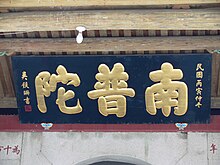South Putuo Temple
| South Putuo Temple | |
|---|---|
| 南普陀寺 | |
 |
|
| Basic information | |
| Location | Xiamen |
| Affiliation | Buddhism |
| Country | China |
| Website | www |
South Putuo or Nanputuo (Chinese: 南普陀寺; pinyin: Nán Pǔtuó Sì; Pe̍h-ōe-jī: Lâm-phó͘-tô-sī) is a famous Buddhist temple founded in the Tang Dynasty in the Chinese city of Xiamen. It is so named because it is south of the Buddhist holy site Mount Putuo in Zhejiang Province.
The South Putuo Temple is located on the southeast of Xiamen Island. It is surrounded by the graceful sea and the Wulao Peaks behind the temple. The Wulao peaks is a small mountain range that rises on the island. It enjoys a picturesque view of Xiamen and the surrounding district of Haicang, Gulangyu and Zhangzhou City. South Putuo Temple has many deep caves and verdant woods. It is adjacent to Xiamen University and Lu River.
During the remaining years of the Tang dynasty, the monks who inhabited the place had established it into a Buddhist sacred land. It used to have different names. In 1684, around the beginning of the Qing dynasty, general Shi Liang provided funds to rebuild the temple, where the Bodhisattva Guanyin was mainly worshipped. The general named it after the Buddhist holy site Mount Putuo of Zhejiang Province, which is considered the abode of Guanyin. In 1924, Hui Quan was appointed the first abbot of the South Putuo Temple and other masters like Hong Yi and Yin Shun taught here. The temple underwent further renovation in the 1980s.
...
Wikipedia
